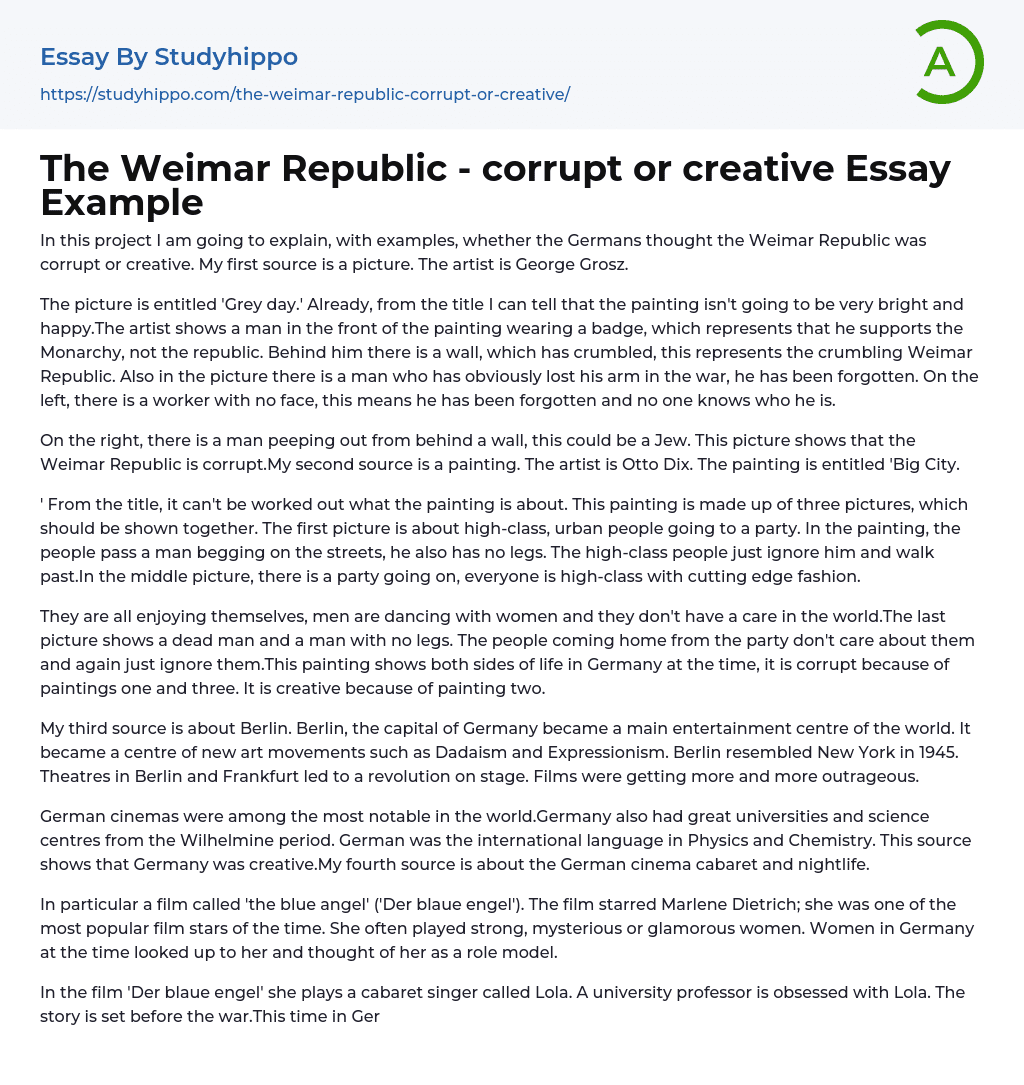In this project I am going to explain, with examples, whether the Germans thought the Weimar Republic was corrupt or creative. My first source is a picture. The artist is George Grosz.
The picture is entitled 'Grey day.' Already, from the title I can tell that the painting isn't going to be very bright and happy.The artist shows a man in the front of the painting wearing a badge, which represents that he supports the Monarchy, not the republic. Behind him there is a wall, which has crumbled, this represents the crumbling Weimar Republic. Also in the picture there is a man who has obviously lost his arm in the war, he has been forgotten. On the left, there is a worker with no face, this means he has been forgotten and no one knows who he is.
On
...the right, there is a man peeping out from behind a wall, this could be a Jew. This picture shows that the Weimar Republic is corrupt.My second source is a painting. The artist is Otto Dix. The painting is entitled 'Big City.
' From the title, it can't be worked out what the painting is about. This painting is made up of three pictures, which should be shown together. The first picture is about high-class, urban people going to a party. In the painting, the people pass a man begging on the streets, he also has no legs. The high-class people just ignore him and walk past.In the middle picture, there is a party going on, everyone is high-class with cutting edge fashion.
They are all enjoying themselves, men are dancing with women and they don't hav
a care in the world.The last picture shows a dead man and a man with no legs. The people coming home from the party don't care about them and again just ignore them.This painting shows both sides of life in Germany at the time, it is corrupt because of paintings one and three. It is creative because of painting two.
My third source is about Berlin. Berlin, the capital of Germany became a main entertainment centre of the world. It became a centre of new art movements such as Dadaism and Expressionism. Berlin resembled New York in 1945. Theatres in Berlin and Frankfurt led to a revolution on stage. Films were getting more and more outrageous.
German cinemas were among the most notable in the world.Germany also had great universities and science centres from the Wilhelmine period. German was the international language in Physics and Chemistry. This source shows that Germany was creative.My fourth source is about the German cinema cabaret and nightlife.
In particular a film called 'the blue angel' ('Der blaue engel'). The film starred Marlene Dietrich; she was one of the most popular film stars of the time. She often played strong, mysterious or glamorous women. Women in Germany at the time looked up to her and thought of her as a role model.
In the film 'Der blaue engel' she plays a cabaret singer called Lola. A university professor is obsessed with Lola. The story is set before the war.This time in Germany was a golden age for cinema.
They had an extremely well known director called Fitz Lang; he produced epic films such as Metropolis. This was the most technically advanced
film of the decade.German cinema suggests that Germany was creative at the time.Now on to cabaret and nightlife. Berlin became famous for its nightlife. As well as theatres and cinemas there was a vibrant nightclub scene which involved daring floor shows, risqu� songs and naked dancing.
To German people this seemed very experimental and shocking. Berlin was also famous for its transvestite balls. Every subject was discussed openly, before the war, these subjects had never been talked about openly. Now things like this were not frowned upon, at least in Berlin. This source shows that the Republic was corrupt.Looking at all of these sources, I have come to the conclusion that the Weimar Republic was both corrupt and creative.
There was something for everyone in Germany because of the nightlife and cabaret and those who didn't enjoy things like that could go to all of the new art galleries and watch films. Germany was obviously a bad place to live in for some people, such as ex army officers and poor people. For the people with money life was easy and they had nothing to worry about.
- Creativity essays
- Art History essays
- Theatre essays
- Pastoral essays
- Visual Arts essays
- Postmodernism essays
- Symbolism essays
- ballet essays
- Color essays
- Modernism essays
- Mona Lisa essays
- Work of art essays
- Body Art essays
- Artist essays
- Cultural Anthropology essays
- Ethnography essays
- Aesthetics essays
- Realism essays
- Heritage essays
- Harlem Renaissance essays
- Concert Review essays
- Voice essays
- Theatre Of The Absurd essays
- Playwright essays
- Scotland essays
- Tennessee williams essays
- Design essays
- Graffiti essays
- Graphic essays
- Typography essays
- Painting essays
- Photography essays
- Sculpture essays
- Architecture essays
- Interior design essays
- Arch essays
- Area essays
- Tattoo essays
- Pablo Picasso essays
- Vincent Van Gogh essays
- Michelangelo essays
- Frida Kahlo essays
- John Locke essays
- 9/11 essays
- A Good Teacher essays
- A Healthy Diet essays
- A Modest Proposal essays
- A&P essays
- Academic Achievement essays
- Achievement essays




